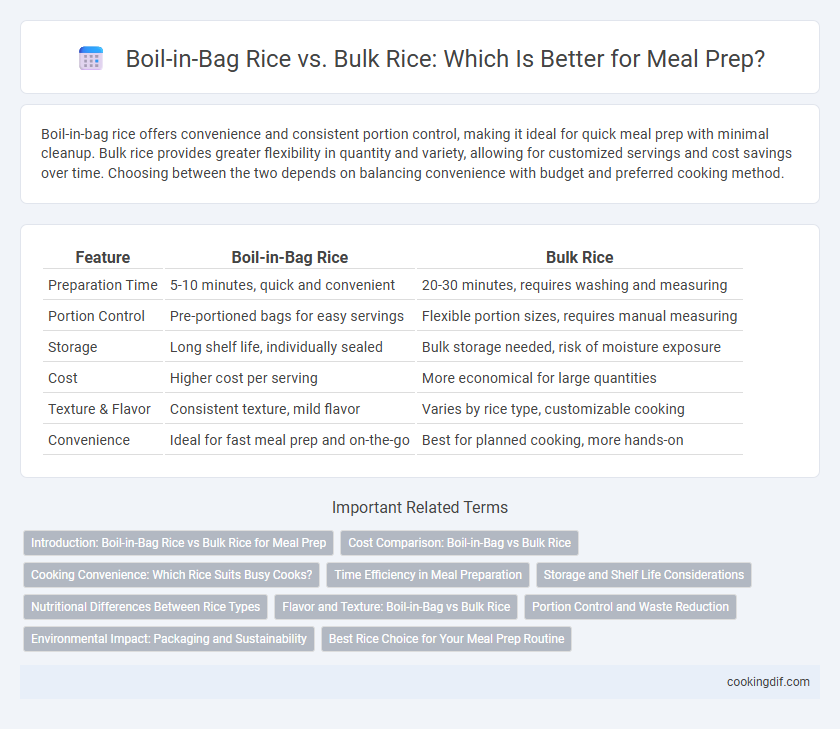Boil-in-bag rice offers convenience and consistent portion control, making it ideal for quick meal prep with minimal cleanup. Bulk rice provides greater flexibility in quantity and variety, allowing for customized servings and cost savings over time. Choosing between the two depends on balancing convenience with budget and preferred cooking method.
Table of Comparison
| Feature | Boil-in-Bag Rice | Bulk Rice |
|---|---|---|
| Preparation Time | 5-10 minutes, quick and convenient | 20-30 minutes, requires washing and measuring |
| Portion Control | Pre-portioned bags for easy servings | Flexible portion sizes, requires manual measuring |
| Storage | Long shelf life, individually sealed | Bulk storage needed, risk of moisture exposure |
| Cost | Higher cost per serving | More economical for large quantities |
| Texture & Flavor | Consistent texture, mild flavor | Varies by rice type, customizable cooking |
| Convenience | Ideal for fast meal prep and on-the-go | Best for planned cooking, more hands-on |
Introduction: Boil-in-Bag Rice vs Bulk Rice for Meal Prep
Boil-in-bag rice offers convenience and precise portion control, making it ideal for quick meal prep and minimizing cleanup. Bulk rice provides greater cost efficiency and customization in quantity, appealing to those who prefer buying in larger amounts or experimenting with recipes. Understanding these differences helps optimize meal planning based on time, budget, and cooking preferences.
Cost Comparison: Boil-in-Bag vs Bulk Rice
Boil-in-bag rice typically costs more per serving compared to bulk rice due to individual packaging and convenience factors, averaging around $0.30 to $0.50 per bag versus $0.10 to $0.20 per serving for bulk rice. Bulk rice requires upfront investment and proper storage but yields a lower cost per meal, making it more economical for large-scale meal prep. Evaluating cost efficiency depends on meal prep frequency, storage capacity, and the value placed on cooking convenience.
Cooking Convenience: Which Rice Suits Busy Cooks?
Boil-in-bag rice offers unmatched cooking convenience for busy cooks, eliminating the need for measuring and cleaning up, as the rice is pre-portioned and cooks evenly within the sealed bag. Bulk rice requires precise water measurements and longer cooking times but provides greater flexibility in portion size and cost-effectiveness for meal prep. For time-saving meal preparation, boil-in-bag rice suits those prioritizing speed and ease, while bulk rice appeals to cooks valuing customization and budget control.
Time Efficiency in Meal Preparation
Boil-in-bag rice significantly reduces meal preparation time by eliminating the need for measuring and monitoring cooking, allowing for precise portion control and consistent results. Bulk rice requires more time for rinsing, measuring, and careful water-to-rice ratio adjustments, which can lengthen overall cooking time. For busy meal preppers, boil-in-bag rice offers a convenient, time-saving solution that minimizes cleanup and speeds up the cooking process.
Storage and Shelf Life Considerations
Boil-in-bag rice typically offers extended shelf life due to its vacuum-sealed packaging, protecting it from moisture and contaminants, making it ideal for long-term storage in meal prep scenarios. Bulk rice, while often more cost-effective and available in larger quantities, requires airtight containers and a cool, dry environment to prevent spoilage and pest infestation. Proper storage conditions for both types significantly impact their quality and usability over time, with boil-in-bag rice generally requiring less stringent measures.
Nutritional Differences Between Rice Types
Boil-in-bag rice often undergoes pre-cooking and packaging processes that may slightly reduce its nutrient content, especially in water-soluble vitamins like B vitamins and some antioxidants. Bulk rice typically retains more of its natural nutrients, including higher fiber levels in whole grain varieties such as brown or wild rice. For meal prep, choosing bulk rice ensures better nutritional retention and greater control over portion size and seasoning.
Flavor and Texture: Boil-in-Bag vs Bulk Rice
Boil-in-bag rice offers consistent texture and uniform cooking, preserving a mild flavor that complements various dishes without overpowering them. Bulk rice allows greater control over flavor infusion and texture, enabling customization through rinsing, soaking, or adding spices during cooking. While boil-in-bag rice provides convenience and reliability, bulk rice results in more vibrant taste and tailored texture ideal for diverse meal prep preferences.
Portion Control and Waste Reduction
Boil-in-bag rice offers precise portion control by providing individually sealed servings, reducing the risk of overcooking and food waste compared to bulk rice. Bulk rice often requires measuring and can lead to excess cooking, increasing the chance of leftovers and spoilage. Choosing boil-in-bag rice streamlines meal prep efficiency while minimizing waste and ensuring consistent portion sizes.
Environmental Impact: Packaging and Sustainability
Boil-in-bag rice generates significantly more plastic waste due to individual packaging, contributing to environmental pollution compared to bulk rice, which reduces single-use plastics by using larger, recyclable bags. Bulk rice also minimizes transportation emissions through denser packaging, optimizing storage and distribution efficiency. Choosing bulk options supports sustainability efforts by lowering overall packaging waste and carbon footprint associated with meal prep staples.
Best Rice Choice for Your Meal Prep Routine
Boil-in-bag rice offers convenience and precise portion control, making it ideal for quick meal prep with minimal cleanup. Bulk rice provides greater cost efficiency and variety, allowing for larger batch cooking and customization of rice types. Choosing between boil-in-bag and bulk rice depends on your priorities for time-saving, cost-effectiveness, and meal variety in your meal prep routine.
Boil-in-bag rice vs Bulk rice for meal prep Infographic

 cookingdif.com
cookingdif.com